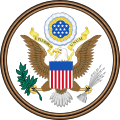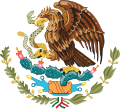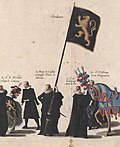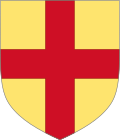Coat of arms
A coat of arms is a unique design painted on a shield. These designs may be inherited, meaning that they pass from a father to his children. In the Middle Ages, these designs were shown on real shields, but today they are usually only drawn or painted on the paper that makes them legal which is called a grant of arms. The grant of arms is usually allowed only when it is given by the government of a country or its agent. In England, this is called the College of Arms and in Scotland is called the Lord Lyon King of Arms.
Coats of arms are normally issued for real people. Nowadays, lots of countries and businesses also have coats of arms. Each symbol on the coat of arms will represent something that has an important meaning to that person, country or company.
Coats of arms have many base shield designs that can be added on to, such as the Fess, Pale, Bend, Chevron, Saltire, and many more. These examples shown are called "Ordinaries". An example of an item to add on to the base designs are called charges. These charges can be classified as emblems added on to the coat of arms base shield. It is also optional to have a supporter. In simple terms, the supporter is usually an animal seeming like it is holding up the shield of the coat of arms. The Royal Coat of Arms of The United Kingdom seen below is an example of supporters. Lastly, the final main piece of many coats of arms is called the crest. The crest is a symbol of some sorts usually resting on top of the shield base of the coat of arms. This crest can be any shape, but usually has to fit within the color palette.
Examples
Coat of arms of Pope Benedict XVI
Coat of arms of Broceni
Royal coat of arms of the United Kingdom
Coat of arms of Pichilemu
Coat of arms of The United States
The coat of arms of Bangladesh
Coat of Arms of Mexico
Coat Of Arms Media
Coats of Arms in the Dering Roll, an English armorial from the 13th century
Brabant Lion held by Floris de Merode during the funeral of Albert VII, Archduke of Austria, print after design by Jacob Franquart
The German Hyghalmen Roll, c. late 15th century, illustrates the German practice of thematic repetition from the arms in the crest
Arms of the Duke of Richmond c. 1780
Arms of the Anglo-Irish House of Burgh
Related pages
Other websites
- Heraldry in the SCA Archived 2008-12-27 at the Wayback Machine
- Modar's Heraldry Archived 2006-12-08 at the Wayback Machine














